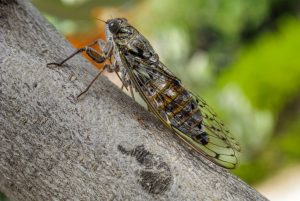 Cicadas arise through 1/2 diameter holes in the ground in May to late June as odd-looking nymphs that have been feeding on the roots of trees and shrubs. The nymphs climb up walls or trees and emerge as adults, leaving the skins of the nymphs clinging to the base of the walls or tree trunks. Sometimes the empty skins are described as “ghost bugs.”
Cicadas arise through 1/2 diameter holes in the ground in May to late June as odd-looking nymphs that have been feeding on the roots of trees and shrubs. The nymphs climb up walls or trees and emerge as adults, leaving the skins of the nymphs clinging to the base of the walls or tree trunks. Sometimes the empty skins are described as “ghost bugs.”
The adults are approximately two inches long, with large wings that fold over their backs. Cicadas have chunky bodies and bulging eyes. They fill the air with a cacophony of vibrating ribbed plates through August. The male cicada may be the loudest insect known; the mating sound can be heard as far as 440 yards.
Female cicada cut a small slits in the tender tree branches and depositing her eggs in the slits. When the eggs hatch, the nymphs drop to the ground and burrow into the soil in search of food. Damage caused to a tree by the cicada in their egg laying process is beneficial to a tree as it is considered a non-harmful natural pruning process.
Source:
7 Things You Didn't Know About Cicadas | U.A. Cooperative Extension (formerly maintained by Maricopa County Cooperative Extension Home Horticulture Site)
Find the information you need by calling the library's Infoline at 520-791-4010 or by sending your question to Ask a Librarian.
